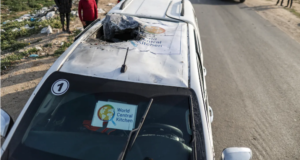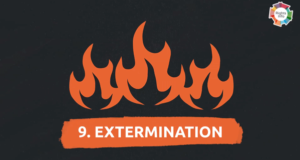Eva Bartlett | In Gaza
January 28, 2009
Two of her boys worked to pull pieces of clothing, books, and anything reachable from under the toppled cupboard. Every item is sacred. She led me through her house, pointing out the many violations against their existence, every graffitied wall, each shattered window and glass and plate, slit flour bags –when the wheat is so precious –and the same revolting array of soldiers’ left-overs:spoiled packaged food, feces everywhere but the toilet, clothes used as toilet paper. The same stench.
“They broke everything, broke our lives. That was the boys room,” we continue through the wreckage. “Look, look here. See that?! Look at this!” This is to be the refrain as we step over destroyed belongings into destroyed rooms.
It isn’t only the destruction, defiling, vandalizing, waste… it’s also the interruption of life, a life already interrupted by the siege. She held out school books, torn, ruined, and asked how her children were supposed to study: when they have no books, no power, had to flee their home, are living in constant fear of another bombardment of missiles (from the world’s 4th most powerful and most abundantly-equipped military).
Some of the graffiti reads:
“We don’t hate Arabs, but will kill every Hamas.”
and
“IDF was here! We know you are here. We won’t kill you, you will live in fear and run all your lives!”
For people in families like hers, the surviving members, this psychological terror is real. For those who have been killed already, the “we won’t kill you,” is a lie. Ask the surviving fathers, mothers, siblings, children.
From the rooftop, we see neighbouring houses inflicted with the wrath of the Israeli military machine. And great swathes of land which once held homes and trees, now naked, stubbled with pillar fragments at painful angles, rubble, stumps, and tank tracks.
“Here, here, come look over here, over here.”
“That was all our land: clementines, lemons, olives…”
“That’s my brother’s house over there, its all broken…”
The drones were still overhead, the words too urgent, too many, too fast, too dizzying.
Down to ground zero and on to more newly wrecked houses and lives. Past a water pump which served at least 10 houses in the area, hit by missiles, ruined.
Passing more shells of houses, I meet Yasser abu Ali, co-owner of a paint and tools supply shop bombed to the ground by 2 F-16 missiles. Seventeen people were immediately dependent on the revenue from the business, not accounting for indirect dependents (suppliers, buyers). As abu Ali tells of he and his brothers’ $200,000 loss, it comes out that he is a cousin of Dr. Ezz-El-Din Abu El-Eish, the doctor whose 3 daughters and neice were killed by Israeli shelling on his house in Jabaliya. Everyone has their own story, and stories overlap, tragedies overlap and compound.
At Samir Abed Rabbo’s, the tour begins as with the others: everything is broken and upside down, there are Israeli soldiers’ leavings (food, playing cards, feces…) and graffiti: “Join the Israeli army today!” and other slogans from the patriotic invading and occupying forces.
The house is more holes than walls, from multiple tank shells to automatic gunfire shots from the tanks. Seeing so many intentionally & deviously-ruined houses dulls the concept of damage. But strangely some things stand out as odd or notable amidst the whole-scale destruction. Entrails of ceilings and support beams hang in threads. A chair sits gutted.
And there are the sniper holes. I look out the hole facing Salah el Din street, the Dawwar Zimmo crossroads, and I realize that it was from one of these very holes that Hassan would have been shot, thankfully not killed (unlike the 13 other emergency medical workers), thankfully we also weren’t shot dead. These sniper holes litter house walls in homes all over Jabaliya, Attatra, Zaitoun…Gaza.
The baby’s bedroom, not saved from the attacks. A wall of cheerful cartoons and cute baby posters contrasts the ugliness of the gaping shelling wounds, reminding that nothing is sacred to an army that will shoot children point-blank [i will tell of this in a later post].
The rotting donkey out back explains the stink, a stench different than that of the army’s usual odor.
Leaving Samir Abed Rabbo’s ruins, I see a newly-homeless family making tea over a fire, behind the rubble of their former home.
Saed Azzat Abed Rabbo stands under a missile hole in his bedroom ceiling, explaining that on the first day of the land invasion, he and family had been in the house when a missile struck it. They frantically evacuated to a school in Jabaliya, Feluja, and only learned of their house’s post-occupation demise upon returning after the Israeli soldiers left.
It is like the others: ravaged, left with soldiers’ waste and wine bottles–Hebrew writing on the label (wine isn’t available here anyway, so there’s no question who drank the wine) –rooftop water tank blown apart, and rooftop views affording more sights of neighbourhood destruction and of the lemon trees that once stood near Saed Abed Rabbo’s home.
I left Abed Rabbo that day, weaving amongst taxis, motorbikes, trucks, and carts packed with belongings, people who had no home to stay in, who’d only come to retrieve what they could from their former lives. I’d seen more than I felt I could internalize or reproduce for others, but knew I’d go back for more stories because I knew there are more. More than I can possibly hear or pass on.
 International Solidarity Movement Nonviolence. Justice. Freedom.
International Solidarity Movement Nonviolence. Justice. Freedom.


